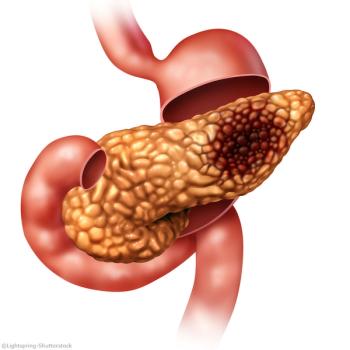
Oncology NEWS International
- Oncology NEWS International Vol 15 No 11
- Volume 15
- Issue 11
Sunitinib Effective in Imatinib-Resistant GIST Patients
Sunitinib malate (Sutent)is an effective treatment option forpatients with gastrointestinal stromal tumor(GIST) after imatinib mesylate(Gleevec) therapy has failed, accordingto a multicenter, randomized, placebocontrolledphase III clinical trial.
BOSTON-Sunitinib malate (Sutent) is an effective treatment option for patients with gastrointestinal stromal tumor (GIST) after imatinib mesylate (Gleevec) therapy has failed, according to a multicenter, randomized, placebocontrolled phase III clinical trial.
George D. Demetri, MD, of Dana-Farber Cancer Institute, and his colleagues recently reported the findings in The Lancet (368:1329-1338, 2006). The results were initially presented at the 2006 Gastrointestinal Cancers Symposium (see ONI February 2006, page 26).
Imatinib, a selective inhibitor of the KIT and PDGFR kinases, is an effective agent for patients with advanced GIST, but the pivotal study of imatinib in GIST showed that 5% of patients had primary resistance to the agent and another 14% developed early resistance.
Sunitinib is an oral multitargeted receptor tyrosine kinase inhibitor that blocks not only KIT and PDGFR but also VEGFR-1, 2, and 3, FLT3, and RET. “Although both sunitinib and imatinib bind within the ATP-binding domain of both KIT and PDGFRs, they are members of different chemical classes and presumably have different binding characteristics and affinities,” Dr. Demetri and his colleagues said.
The study enrolled 312 patients with malignant GIST that was not amenable to surgery, radiation, or a combination of different approaches with curative intent, and confirmed objective failure of previous imatinib therapy. They were randomized in a 2:1 ratio to sunitinib or placebo daily for 4 consecutive weeks followed by a 2-week rest period. Sunitinib was given at a starting dose of 50 mg/d. The primary endpoint was time to tumor progression as defined by RECIST.
Trial Unblinded Early
The study was unblinded early when the planned interim analysis, performed after the first 149 cases of disease progression or death, demonstrated significantly longer time to tumor progression among the sunitinib patients, compared with the placebo patients. After unblinding, all patients were allowed to cross over to open-label sunitinib.
For the intent-to-treat population, median time to tumor progression was four times longer with sunitinib-27.3 weeks vs 6.4 weeks for placebo (P < .0001). “A clear difference between the treatment groups was noted around week 4,” Dr. Demetri said. Further analyses showed similar benefits of sunitinib across subgroups, including subgroups by age, weight, race, pain score, performance status, time since initial diagnosis, duration or dose of initial imatinib treatment, and study location.
The median duration of progression free survival was also quadrupled: 24.1 weeks for sunitinib vs 6 weeks for placebo (HR 0.33, P < .0001). Overall survival was significantly better in the sunitinib group, despite the crossover option (HR 0.49, P = .007), but a median overall survival value could not be calculated because more than half of the sunitinib patients were still alive at the time of the interim analysis.
Objective Responses Uncommon
In the sunitinib group, 14 patients (7%) had a partial response as their best response, while 120 (58%) had stable disease, compared with 0% and 48%, respectively in the placebo arm. “Although relatively low, the confirmed objective response rate was significantly higher in the sunitinib than in the placebo group (P = .006),” Dr. Demetri said.
Among the 13 patients who were intolerant to imatinib, 4 of the 9 who received sunitinib had a partial response and only 1 progressed, compared with no responses among the 4 imatinibintolerant patients on placebo and 3 cases of disease progression.
The investigators noted that adverse events were “generally mild to moderate in intensity and easily managed by dose reduction, dose interruption, or standard supportive medical treatments.”
Suggested Strategies
A suggested strategy for management of imatinib resistance in GIST patients is to increase the imatinib dose to 800 mg daily, but the study authors noted that the median time of benefit with this dose increase is fairly short at an estimated 11.6 weeks. Based on their study, Dr. Demetri and his colleagues suggested an alternative strategy of switching from lower-dose imatinib directly to sunitinib. “Further research is needed to clarify which treatment algorithm will lead to the best clinical outcomes,” they said.
Commentator Heikki Joensuu, MD, of Helsinki University Central Hospital, Finland, noting that the benefits of sunitinib in the study were “only moderate . . . and might have been less if imatinib had been continued in the control arm,” suggested several alternative strategies to manage advanced GIST that progresses during imatinib therapy:
• Surgery, when only one or a few growing metastases are detected.
• Check for imatinib compliance.
• Check for co-medication such as enzyme- inducing antiepileptic drugs that may require patients to take a higher imatinib dose (up to 800 to 1,000 mg/d).
• Imatinib dose escalation from 400 mg/d to 800 mg/d.
• Use of sunitinib.
• Participation in a clinical trial.
Articles in this issue
about 19 years ago
High ERCC1 Levels Predict Cisplatin Resistanceabout 19 years ago
CT Screening Detects Curable Stage I Lung Cancerabout 19 years ago
Triple-Negative Ca’s Respond to Optimized Taxane Chemotherapyabout 19 years ago
Avastin Approved as First-Line Rx of Nonsquamous NSCLCabout 19 years ago
Rituxan Receives FDA Approval for 2 New NHL Indicationsabout 19 years ago
Lapatinib Benefit Seen in Inflammatory Breast Cancerabout 19 years ago
Sinking Health Care Ship Could Bring Down the Economyabout 19 years ago
Breast Ultrasound Referrals Often Lack Important Infoabout 19 years ago
FDA Okays Zolinza for CTCL Skin LesionsNewsletter
Stay up to date on recent advances in the multidisciplinary approach to cancer.

























































































